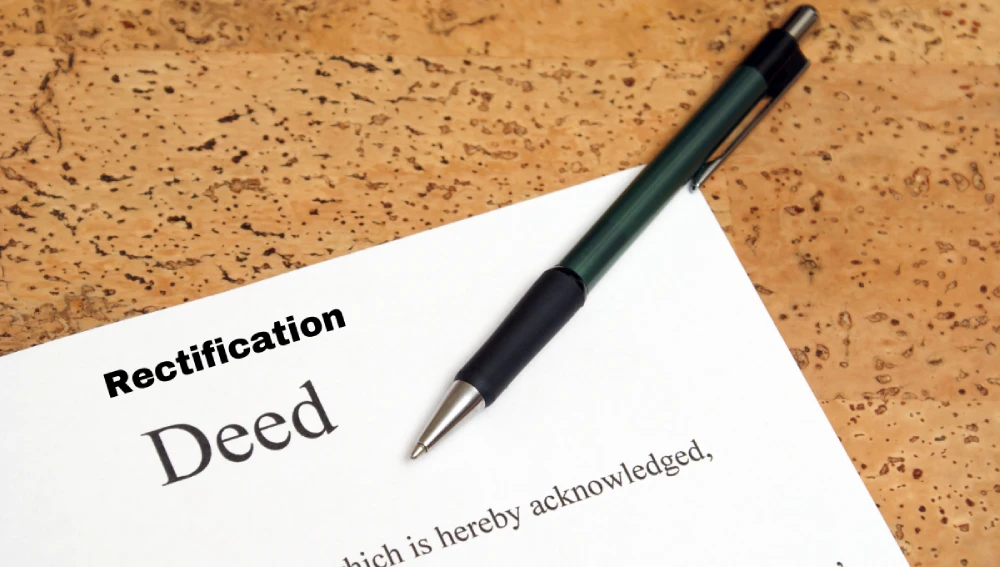As a property buyer, seller, or real estate professional, you may encounter errors or inaccuracies in property-related documents, such as sale deeds, title deeds, or purchase agreements. This blog aims to give you a full understanding of rectification deeds. And ensure that your property transactions are smooth and hassle-free.
What is a Rectification Deed

A rectification deed is a legal tool. It corrects errors in past property documents, like sale deeds, title deeds, and purchase agreements. It ensures that the document reflects the parties’ original intent. It prevents disputes from clerical mistakes.
Conditions for executing a rectification deed
- The error in the original deed must be genuine and unintentional.
- All parties involved in the original deed must mutually agree to the rectification.
- The rectification deed can only correct factual errors and not legal mistakes.
- Both parties ‘ interests should remain the same due to the rectification.
- The sub-registrar must be convinced that the error in the original document was inadvertent.
- The parties must appear before the sub-registrar to register the rectification deed.
What is the time limit for executing a rectification deed?
There is no specific time limit prescribed by law for executing a rectification deed. However, it is advisable to correct errors as soon as they are discovered to prevent any legal complications or disputes.
How much cost of rectification deed stamp duty?
The stamp duty for a rectification deed varies depending on the state and the nature of the error being corrected. In some cases, a nominal fee of Rs. 100 may be charged for minor corrections, while more significant errors may attract higher stamp duty.
How to create a rectification deed?
1. Identifying the error.
2. Draft a rectification deed that includes:
- Corrective statement outlining the text that needs correction.
- Reference to the original document, including the date and parties involved.
- Mutual agreement clause confirming all parties agree to the corrections.
3. Get signatures from all parties in the original document. If the original owner has passed away, their legal heirs must be involved.
4. Both parties must go to the sub-registrar with supporting documents and pay the stamp duty.
How to register a rectification deed?
- Visit the sub-registrar’s Office
Both parties involved must visit the sub-registrar’s office where the original deed was registered. This is required even if the rectification deed is being executed online.
- Apply.
Apply the sub-registrar seeking correction of the error in the original document. Attach all supporting documents proving the error.
- Pay the stamp duty.
This is usually a nominal fee of Rs. 100 for minor corrections. However, if major changes are being made, higher stamp duty may be applicable.
- Witness Requirement
If the original document is changing a lot, the sub-registrar may require two witnesses from each party to be present.
- Online Registration
Some states allow online appointments and stamp duty payments for rectification deeds.
State-wise official sites for rectification deed
Many states in India have dedicated websites for online registration of rectification deeds. Some prominent states websites are as follows:
– Bihar: http://bhumijankari.bihar.gov.in
– Delhi: http://revenue.delhi.gov.in
– Gujarat: https://services.india.gov.in
– Karnataka: https://kaverionline.karnataka.gov.in
– Maharashtra: https://gras.mahakosh.gov.in/igr/
– Tamil Nadu: https://tnreginet.gov.in
– Uttar Pradesh: https://igrsup.gov.in
Rectification deed format
1. Corrective statement: Clearly outlines the error and the correction.
2. Original document reference: It includes its date and parties involved.
3. Mutual agreement clause: Confirms that all parties agree to the correction.
The format below can change based on the specific requirements. It is for the changes to the original property document.
| This deed of rectification is executed at [Place], on [Date], between:[Name], son/daughter of [Father’s Name], residing at [Address], hereinafter referred to as the “Rectifier/Vendor”, which term includes its successors and assigns of the ONE PART; And[Name], son/daughter of [Father’s Name], residing at [Address], hereinafter referred to as the “Purchaser/Buyer”, which term includes his heirs, executors, administrators, representatives, and assigns of the OTHER PART. WHEREAS: A. The property was sold by the Rectifier in favour of the Purchaser herein in and by a sale deed dated [Date] and registered as Document No. [Number] in the file of the Sub Registrar of [Location], hereinafter referred to as the “Principal Deed”. B. In the Principal Deed dated [Date] in line [Number] of page number [Number], the [description of error] was wrongly [details of error]. C. This [type of error] has come to the knowledge of the above-said Purchaser and the Purchaser has requested the Rectifier/Vendor to rectify the same. NOW THIS DEED OF RECTIFICATION WITNESSETH AS FOLLOWS: 1. That in the Principal Deed dated [Date] in line [Number] of page number [Number], the [description of error] is hereby rectified as [corrected details]. 2. That no consideration has been received by the Rectifier for executing this Deed of Rectification. IN WITNESS WHEREOF, the parties have executed this Deed of Rectification on the day, month, and year first above written. [Signatures of Rectifier/Vendor and Purchaser/Buyer] Witnesses: 1. [Name, Address] 2. [Name, Address] This rectification deed format includes: 1. Proper identification of the parties involved. 2. Recitals stating the background and reason for rectification. 3. The operative part clearly states the correction being made. 4. Confirmation of no additional considerations. 5. Signatures of the parties and witnesses. |
Key facts to remember about the rectification deed.

1. Honest mistake:
The errors in the original document must be genuine and unintentional.
2. Joint execution:
In the rectification deed, both the buyer and the seller should consent to its signing.
3. Registration:
The rectification deed required certain formalities to be complied with to make it effective.
4. Legal remedy against its rectification:
A rectification deed was executed fraudulently or against all the parties’ interests. In that case, it can be contested in court.
Conclusion:
In conclusion, a rectification deed is a necessary legal tool. It fixes mistakes in property documents. But, it lacks power if not done with mutual consent and registration.
FAQ’s
Yes, a rectification deed requires stamp duty. The duty can vary by state and by the kind of error being corrected.
Rectification deeds and correction deeds are used interchangeably. They refer to the same legal tool used to correct errors in property documents.
You can cancel a rectification deed if it has fraud or lacks consent from all the affected parties. In such cases, the affected party can only seek legal redress by suing the deed.

